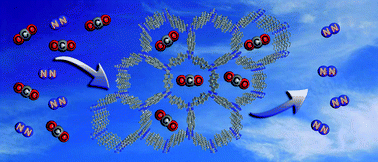A fluorene based covalent triazine framework with high CO2 and H2 capture and storage capacities†
Abstract
Porous organic polymers have come into focus recently for the capture and storage of postcombusted CO2. Covalent triazine frameworks (CTFs) constitute a nitrogen-rich subclass of porous polymers, which offers enhanced tunability and functionality combined with high chemical and thermal stability. In this work a new covalent triazine framework based on fluorene building blocks is presented, along with a comprehensive elucidation of its local structure, porosity, and capacity for CO2 capture and H2 storage. The framework is synthesized under ionothermal conditions at 300–600 °C using ZnCl2 as a Lewis acidic trimerization catalyst and reaction medium. Whereas the materials synthesized at lower temperatures mostly feature ultramicropores and moderate surface areas as probed by CO2 sorption (297 m2 g−1 at 300 °C), the porosity is significantly increased at higher synthesis temperatures, giving rise to surface areas in excess of 2800 m2 g−1. With a high fraction of micropores and a surface area of 1235 m2 g−1, the CTF obtained at 350 °C shows an excellent CO2 sorption capacity at 273 K (4.28 mmol g−1), which is one of the highest observed among all porous organic polymers. Additionally, the materials have CO2/N2 selectivities of up to 37. The hydrogen adsorption capacity of 4.36 wt% at 77 K and 20 bar is comparable to that of other POPs, yet the highest among all CTFs studied to date.


 Please wait while we load your content...
Please wait while we load your content...